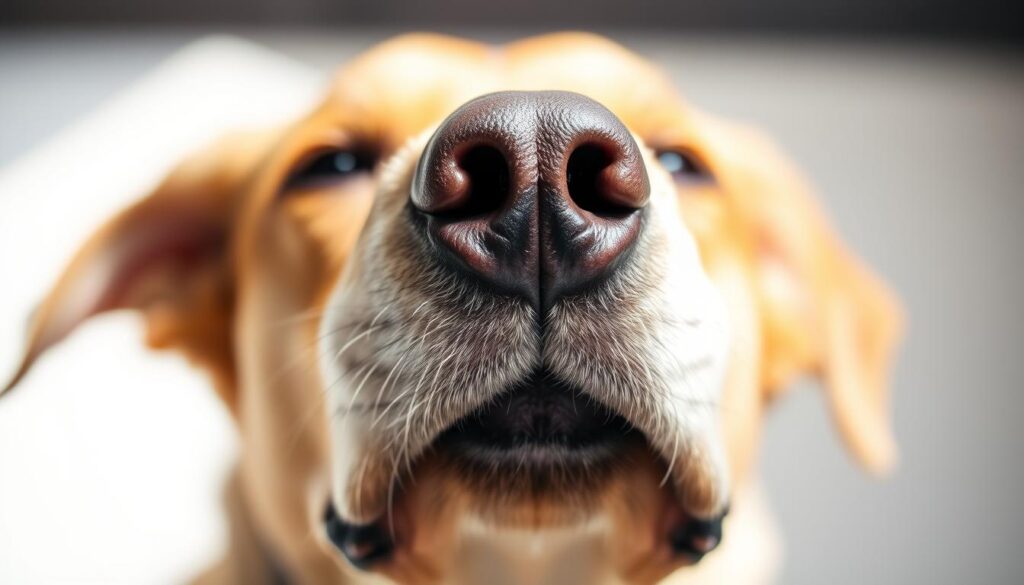If you own a dog, you might have seen them breathing fast without panting. This can be a worrying sign. There are many reasons why dogs might breathe quickly, like health issues or environmental factors. Fast breathing can be normal when dogs are active or stressed, but shallow breathing might mean there’s a problem.

It’s important to know why dogs breathe quickly without panting to keep them healthy. In this article, we’ll explore the reasons and solutions for this issue. We’ll look at common health problems and environmental factors that can affect dog breathing.
Key Takeaways
- Fast breathing in dogs can be a normal response to exercise or stress
- Shallow breathing in dogs can be a sign of an underlying medical issue
- Dog breathing fast but not panting can be caused by various factors, including medical conditions or environmental factors
- Understanding the possible reasons behind rapid dog breathing without panting is crucial for ensuring your dog’s respiratory health
- Rapid breathing in dogs can be a sign of a serious medical condition, such as heart disease or respiratory infection
- Environmental factors, such as heat or humidity, can contribute to rapid breathing in dogs
Normal Breathing Patterns in Dogs
As a dog owner, knowing normal breathing patterns is key. Dog rapid breathing can signal trouble. Keep an eye on your dog’s breathing rate to check their health.
Dogs breathe between 10 to 35 times a minute on average. To check, watch their chest or feel their breath. It’s important to know the difference between normal breathing and panting. Panting helps dogs cool down.
Average Respiratory Rate for Dogs
Dogs breathe 10 to 35 times a minute, but it changes with age, size, and breed. Smaller dogs breathe faster than bigger ones.
Difference Between Normal Breathing and Panting
Normal breathing is steady and rhythmic. Panting is faster and shallower. Panting is how dogs cool down, but it can also mean stress or anxiety.

How to Count Your Dog’s Breathing Rate
To count your dog’s breathing, follow these steps:
- Watch your dog’s chest rise and fall
- Count their breaths per minute
- Notice any changes in their breathing
By watching your dog’s breathing, you can spot problems early. If you see anything off, get vet help.
Why Is My Dog Breathing Fast But Not Panting?
As a dog owner, you might have seen your dog breathing fast without panting. This could mean there’s a health issue. Factors like anxiety, stress, and medical conditions can cause this. It’s key to find out why your dog is breathing fast to help them.
Some common reasons for dog breathing problems include respiratory infections, heart conditions, and lung diseases. These can make breathing hard for dogs, which is serious. Watching your dog’s dog breathing rate can spot problems early.
Here are some possible reasons why your dog may be breathing fast but not panting:
- Anxiety or stress: Dogs can feel anxious or stressed, leading to fast breathing.
- Medical conditions: Certain health issues, like heart disease or respiratory infections, can cause fast breathing in dogs.
- Pain or discomfort: Dogs may breathe quickly if they’re in pain or uncomfortable.

It’s important to see a vet if you notice changes in your dog’s breathing. They can find out what’s causing it and help fix it. By watching your dog’s dog breathing rate and getting vet care when needed, you can keep your dog healthy.
Common Medical Causes of Rapid Breathing
As a dog owner, it’s key to know that fast breathing can mean a health issue. Labored breathing in dogs can point to heart problems, respiratory infections, lung diseases, or anemia. If your dog is breathing quickly but not panting, see a vet to find out why.
Some common reasons for rapid breathing in dogs include:
- Heart conditions, like congestive heart failure, which can cause fast breathing in dogs
- Respiratory infections, like pneumonia, which can make dogs breathe fast but not pant
- Lung diseases, such as COPD, which can lead to labored breathing in dogs
- Anemia, which can lower red blood cells and cause fast breathing in dogs
Working with your vet is crucial to find out why your dog is breathing fast. They can help create a treatment plan. Early action can prevent serious health problems.
Knowing the medical reasons for rapid breathing helps you care for your dog better. This ensures they stay healthy and happy.
Environmental Factors Affecting Dog Breathing
As a dog owner, you want your pet to be comfortable and safe. Environmental factors can greatly affect your dog’s breathing. This can lead to breathing difficulties or problems. Extreme temperatures, humidity, and poor air quality can cause respiratory distress in dogs.
It’s important to have a well-ventilated area for your dog. This can be done by giving them a big room with open windows. You can also use an air purifier to clean the air indoors. Keeping your dog away from polluted places and avoiding strong chemicals or fumes is also key.
Some key environmental factors to consider include:
- Temperature: Extreme heat or cold can cause dog breathing problems.
- Humidity: High humidity can lead to canine respiratory distress.
- Air quality: Poor air quality can exacerbate dog breathing difficulty.
By understanding these environmental factors and taking steps to reduce their impact, you can make a healthier environment for your dog. This will help them breathe better and lower the risk of breathing problems or respiratory distress.
Breed-Specific Breathing Concerns
As a dog owner, it’s key to know that different breeds breathe differently. Abnormal dog breathing patterns are a worry for some. Knowing these differences helps you care for your pet better. Some breeds are more likely to have breathing problems because of their body shape.
It’s important to understand your dog’s dog breathing rate. This helps spot any breathing issues early. By watching your dog’s breathing, you can act fast to keep them healthy.
Brachycephalic breeds, like pugs and bulldogs, often have trouble breathing. This is because of their short noses and long soft palates. Small dogs, like chihuahuas and poodles, breathe fast because they’re always on the go. Big dogs, like mastiffs and great danes, can also have breathing problems because of their size.
- Brachycephalic breeds: Pugs, Bulldogs, and Boston Terriers
- Small dog breeds: Chihuahuas, Poodles, and Pomeranians
- Large dog breeds: Mastiffs, Great Danes, and Irish Wolfhounds
Knowing about these breathing issues in different breeds helps you protect your dog. Keep an eye on your dog’s breathing and see a vet if it’s off. This can prevent serious health problems.
When Rapid Breathing Becomes an Emergency
As a dog owner, it’s key to know when your dog’s fast breathing is urgent. If your dog breathes quickly but doesn’t pant, it might mean they have a health issue. Breathing hard can signal problems like infections, heart issues, or lung diseases. These can be serious, so get vet help fast.
Look out for signs like rapid breathing rate, blue-tinged gums, and difficulty breathing. If you see these, stay calm and act quickly. Try to keep your dog calm and cool while you get vet help.
Warning Signs to Watch For
- Rapid breathing rate
- Blue-tinged gums
- Difficulty breathing
- Coughing or wheezing
Emergency Response Steps
- Stay calm and keep your dog calm
- Keep your dog cool and comfortable
- Seek veterinary attention immediately
If your dog has trouble breathing or shows other signs of distress, get vet help fast. Recognizing the signs and acting quickly can help your dog get the care they need. This way, they can recover from breathing issues.
Diagnostic Procedures for Breathing Issues
If your dog is having trouble breathing or showing signs of canine respiratory distress, it’s important to get help from your vet. They will do a full check-up, ask about your dog’s health history, and check their dog breathing rate.
Tests like blood work and urinalysis might be needed to find out what’s causing the problem. Your vet might also use X-rays or CT scans to look at your dog’s lungs and airways.
Depending on your dog’s symptoms, your vet might suggest more tests. These could include:
- Pulmonary function tests to check lung health
- Arterial blood gas analysis to check oxygen levels
- Thoracic radiographs to look at the chest cavity
By following your vet’s advice and doing these tests, you can find out why your dog is having trouble breathing. This helps your vet create a plan to help your dog feel better and stay healthy.
Treatment Options and Management Strategies
If your dog is breathing fast but not panting, you need to work with your vet. They will help create a treatment plan. This plan might include medical treatments, changes in your dog’s lifestyle, and home care tips. Fast breathing can mean there’s a health issue, like heart disease or a respiratory infection.
Shallow breathing can be caused by many things, like anxiety or respiratory diseases. Your vet might do tests like blood work, imaging, and physical exams to find out why. Once they know the cause, they can help you make a plan to fix it.
Some common treatments for fast breathing in dogs include:
- Medications for conditions like heart disease or respiratory infections
- Changes in your dog’s lifestyle, like keeping them cool and comfortable
- Home care tips, like watching their breathing and making sure they get enough exercise
By following a treatment plan with your vet, you can help your dog breathe better. Remember, fast breathing can be a sign of a serious problem. So, if you notice any changes in your dog’s breathing, get them to the vet right away.
| Treatment Option | Description |
|---|---|
| Medications | Manage underlying medical conditions, such as heart disease or respiratory infections |
| Lifestyle Adjustments | Provide a cool, comfortable environment and reduce stress |
| Home Care Tips | Monitor your dog’s breathing rate and provide regular exercise |
Preventing Respiratory Problems in Dogs
As a dog owner, you are key in keeping your pet’s breathing healthy. Dog breathing issues can come from many sources. These include environmental dangers, unhealthy habits, and medical conditions. To lower the risk, keep your dog at a healthy weight, exercise them regularly, and shield them from harmful pollutants.
Regular vet visits are crucial for checking your dog’s breathing health. Your vet can spot early signs of trouble like fast breathing, coughing, or wheezing. They can also guide you on how to prevent these problems. Together, you can ensure your dog stays happy and healthy.
Here are some ways to prevent dog breathing issues:
- Feed a balanced diet and keep your dog at a healthy weight
- Make sure they get enough exercise and mental stimulation
- Keep them away from harmful environmental pollutants like smoke
- Keep vaccinations and parasite control up to date
- Practice good dental care and hygiene
By following these tips and consulting with your vet, you can lower the risk of breathing problems. This gives your dog the best chance at a long, healthy life.
Conclusion: Ensuring Your Dog’s Respiratory Health
Understanding your dog’s breathing is key to their health. Rapid breathing without panting can be a worry. But, knowing the reasons and getting vet help when needed is important.
Your dog’s breathing health is crucial for their overall well-being. Taking steps to watch and manage any issues can help a lot. This includes knowing about common respiratory problems and how to prevent them.
Regular vet visits, a healthy diet, and a clean, stress-free home are all important. Also, knowing the signs of respiratory trouble and how to act in an emergency is vital. This ensures your dog gets the care they need when it’s most important.
Your dog’s breathing health is something you and your vet should work on together. By being attentive and informed, you can help your dog breathe easily and live a happy, healthy life. Always watch your dog’s breathing and get vet advice if you see any changes. With the right care, your dog’s respiratory health will always be a top priority.
FAQ
What is the average respiratory rate for dogs?
Dogs breathe between 10 to 30 times per minute when they’re calm.
How can I tell the difference between normal breathing and panting in dogs?
Dogs breathe slowly and deeply when they’re relaxed. Panting is fast and shallow. It helps them cool down.
How do I count my dog’s breathing rate?
Watch your dog’s chest or belly for one minute. Count how many times they breathe. This shows their breathing rate per minute.
Why is my dog breathing fast but not panting?
Dogs might breathe fast without panting due to stress, anxiety, or health issues like heart or lung problems.
What are the common medical causes of rapid breathing in dogs?
Heart issues, lung diseases, and infections can make dogs breathe fast. Always check with your vet to find out why.
How can environmental factors affect my dog’s breathing?
Weather, air quality, and humidity can affect your dog’s breathing. Keep their environment clean and comfy to prevent breathing problems.
What breed-specific breathing concerns should I be aware of?
Some breeds, like pugs and bulldogs, have breathing issues. Small and large breeds also face unique challenges. Knowing your dog’s breed helps ensure their breathing health.
When does rapid breathing become an emergency for my dog?
If your dog is breathing hard, seems very tired, or has blue gums, it’s an emergency. Get them to the vet right away.
What diagnostic procedures might my veterinarian use to address my dog’s breathing issues?
Your vet might do physical checks, blood tests, and imaging to find out why your dog is breathing hard.
What treatment options and management strategies are available for dogs with breathing problems?
Treatment depends on the cause. It might include medicine, lifestyle changes, or home care. Always work with your vet to manage your dog’s breathing issues.
How can I prevent respiratory problems in my dog?
Keep your dog at a healthy weight, exercise them regularly, and avoid harmful environments. Follow your vet’s advice to prevent breathing issues.
